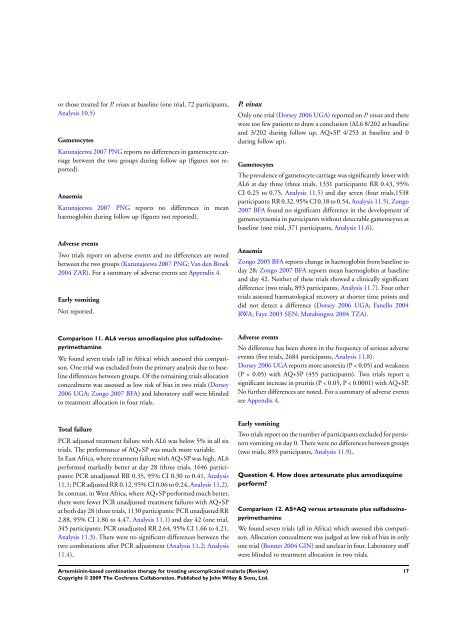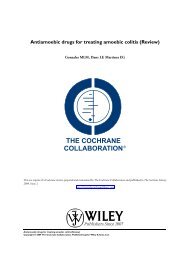Artemisinin-based combination therapy for ... - The Cochrane Library
Artemisinin-based combination therapy for ... - The Cochrane Library
Artemisinin-based combination therapy for ... - The Cochrane Library
You also want an ePaper? Increase the reach of your titles
YUMPU automatically turns print PDFs into web optimized ePapers that Google loves.
or those treated <strong>for</strong> P. vivax at baseline (one trial, 72 participants,<br />
Analysis 10.5)<br />
Gametocytes<br />
Karunajeewa 2007 PNG reports no differences in gametocyte carriage<br />
between the two groups during follow up (figures not reported).<br />
Anaemia<br />
Karunajeewa 2007 PNG reports no differences in mean<br />
haemoglobin during follow up (figures not reported).<br />
Adverse events<br />
Two trials report on adverse events and no differences are noted<br />
between the two groups (Karunajeewa 2007 PNG; Van den Broek<br />
2004 ZAR). For a summary of adverse events see Appendix 4.<br />
Early vomiting<br />
Not reported.<br />
Comparison 11. AL6 versus amodiaquine plus sulfadoxinepyrimethamine<br />
We found seven trials (all in Africa) which assessed this comparison.<br />
One trial was excluded from the primary analysis due to baseline<br />
differences between groups. Of the remaining trials allocation<br />
concealment was assessed as low risk of bias in two trials (Dorsey<br />
2006 UGA; Zongo 2007 BFA) and laboratory staff were blinded<br />
to treatment allocation in four trials.<br />
Total failure<br />
PCR adjusted treatment failure with AL6 was below 5% in all six<br />
trials. <strong>The</strong> per<strong>for</strong>mance of AQ+SP was much more variable.<br />
In East Africa, where treatment failure with AQ+SP was high, AL6<br />
per<strong>for</strong>med markedly better at day 28 (three trials, 1646 participants:<br />
PCR unadjusted RR 0.35, 95% CI 0.30 to 0.41, Analysis<br />
11.1; PCR adjusted RR 0.12, 95% CI 0.06 to 0.24, Analysis 11.2).<br />
In contrast, in West Africa, where AQ+SP per<strong>for</strong>med much better,<br />
there were fewer PCR unadjusted treatment failures with AQ+SP<br />
at both day 28 (three trials, 1130 participants: PCR unadjusted RR<br />
2.88, 95% CI 1.86 to 4.47, Analysis 11.1) and day 42 (one trial,<br />
345 participants: PCR unadjusted RR 2.64, 95% CI 1.66 to 4.21,<br />
Analysis 11.3). <strong>The</strong>re were no significant differences between the<br />
two <strong>combination</strong>s after PCR adjustment (Analysis 11.2; Analysis<br />
11.4).<br />
P. vivax<br />
Only one trial (Dorsey 2006 UGA) reported on P. vivax and there<br />
were too few patients to draw a conclusion (AL6 8/202 at baseline<br />
and 3/202 during follow up, AQ+SP 4/253 at baseline and 0<br />
during follow up).<br />
Gametocytes<br />
<strong>The</strong> prevalence of gametocyte carriage was significantly lower with<br />
AL6 at day three (three trials, 1331 participants: RR 0.43, 95%<br />
CI 0.25 to 0.75, Analysis 11.5) and day seven (four trials,1538<br />
participants: RR 0.32, 95% CI 0.18 to 0.54, Analysis 11.5). Zongo<br />
2007 BFA found no significant difference in the development of<br />
gametocytaemia in participants without detectable gametocytes at<br />
baseline (one trial, 371 participants, Analysis 11.6).<br />
Anaemia<br />
Zongo 2005 BFA reports change in haemoglobin from baseline to<br />
day 28; Zongo 2007 BFA reports mean haemoglobin at baseline<br />
and day 42. Neither of these trials showed a clinically significant<br />
difference (two trials, 893 participants, Analysis 11.7). Four other<br />
trials assessed haematological recovery at shorter time points and<br />
did not detect a difference (Dorsey 2006 UGA; Fanello 2004<br />
RWA; Faye 2003 SEN; Mutabingwa 2004 TZA).<br />
Adverse events<br />
No difference has been shown in the frequency of serious adverse<br />
events (five trials, 2684 participants, Analysis 11.8).<br />
Dorsey 2006 UGA reports more anorexia (P < 0.05) and weakness<br />
(P < 0.05) with AQ+SP (455 participants). Two trials report a<br />
significant increase in pruritis (P < 0.05, P < 0.0001) with AQ+SP.<br />
No further differences are noted. For a summary of adverse events<br />
see Appendix 4.<br />
Early vomiting<br />
<strong>Artemisinin</strong>-<strong>based</strong> <strong>combination</strong> <strong>therapy</strong> <strong>for</strong> treating uncomplicated malaria (Review)<br />
Copyright © 2009 <strong>The</strong> <strong>Cochrane</strong> Collaboration. Published by John Wiley & Sons, Ltd.<br />
Two trials report on the number of participants excluded <strong>for</strong> persistent<br />
vomiting on day 0. <strong>The</strong>re were no differences between groups<br />
(two trials, 893 participants, Analysis 11.9).<br />
Question 4. How does artesunate plus amodiaquine<br />
per<strong>for</strong>m?<br />
Comparison 12. AS+AQ versus artesunate plus sulfadoxinepyrimethamine<br />
We found seven trials (all in Africa) which assessed this comparison.<br />
Allocation concealment was judged as low risk of bias in only<br />
one trial (Bonnet 2004 GIN) and unclear in four. Laboratory staff<br />
were blinded to treatment allocation in two trials.<br />
17








